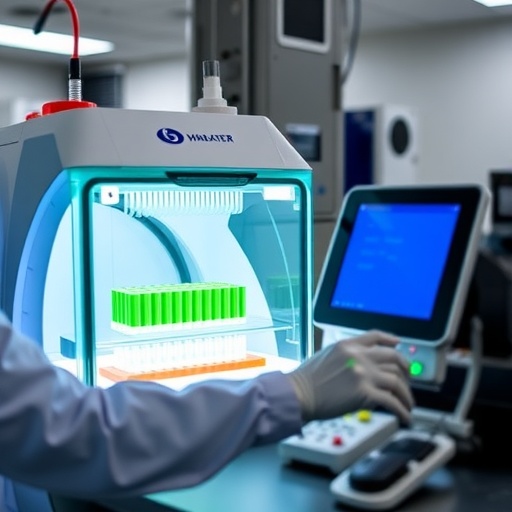
In a groundbreaking advance that promises to reshape the landscape of pancreatic cancer diagnostics, researchers have unveiled innovative 4D-printed microdevices designed for the spatiotemporal detection of circulating tumor DNA (ctDNA) and microRNAs (miRNAs). This cutting-edge technology merges the fields of additive manufacturing, molecular biology, and oncology, offering unparalleled precision in tracking the molecular signatures of one of the deadliest cancers globally. As pancreatic cancer notoriously evades early diagnosis due to its asymptomatic progression and complex biology, these novel microdevices represent a beacon of hope in the push toward personalized medicine and timely intervention.
The principle behind these 4D-printed microdevices lies in their dynamic response capability, which transcends traditional 3D printing by incorporating time as the fourth dimension. This temporal factor enables the devices to morph in response to specific biochemical cues present in the patient’s bloodstream, thereby allowing real-time, spatially resolved molecular detection. The dynamic nature of the material substrates utilized in the printing process facilitates adaptive interactions with ctDNA and miRNA biomarkers, essential indicators of tumor presence and progression in pancreatic cancer patients.
Pancreatic ductal adenocarcinoma (PDAC), the predominant form of pancreatic cancer, often releases trace amounts of nucleic acids such as ctDNA and miRNAs into circulation. These molecular fragments serve as minimally invasive biomarkers that reflect tumor burden, genetic mutations, and therapeutic response. However, the reliable detection of these biomarkers is hampered by their low abundance and the complexity of bodily fluids. The newly developed microdevices leverage highly sensitive sensing elements integrated within a flexible, programmable matrix, enhancing affinity and specificity toward these nucleic acid targets.
The microdevices employ functionalized nanomaterials embedded within the 4D-printed architecture to facilitate selective binding of ctDNA and miRNA molecules. These nanomaterials, often composed of gold nanoparticles, graphene derivatives, or molecularly imprinted polymers, contribute to the amplification of detection signals and reduce background noise. This integration significantly improves the limit of detection, making it feasible to identify minute concentrations of tumor-derived genetic material at early disease stages.
Spatial resolution is another key advantage delivered by these microdevices. By localizing multiple sensing units within a single platform, it becomes possible to map the heterogeneity of tumor-specific biomarkers within the bloodstream. This spatial mapping uncovers variations in genetic mutations or expression profiles that may correlate with tumor microenvironment changes or metastatic potential. Consequently, clinicians can obtain a multidimensional molecular portrait of the cancer, informing more accurate prognosis and tailored treatment regimens.
A crucial feature facilitating these capabilities is the programming of stimuli-responsive materials within the 4D printing process. These materials react to environmental cues such as pH, temperature, or enzymatic activity, altering their conformation and exposing or concealing sensor sites on demand. Through such fine-tuned control, the devices can cycle between binding and release states, enabling repeated measurements from a single sample and reducing patient discomfort associated with frequent blood draws.
The fabrication process integrates advanced additive manufacturing techniques, including digital light processing (DLP) and two-photon polymerization (TPP), enabling microscale precision. This allows the construction of complex three-dimensional microarchitectures with intricate channels and sensor arrays necessary for fluid handling and molecular recognition. The spatial arrangement ensures optimal exposure of target molecules to sensing surfaces, maximizing interaction efficiency.
Importantly, the deployment of these microdevices aligns with the burgeoning field of liquid biopsy, which aims to revolutionize cancer diagnosis and monitoring by replacing invasive tissue biopsies with simple blood tests. Compared to conventional diagnostic tools, liquid biopsy provides the advantage of continuous, real-time tracking of tumor dynamics, enabling rapid detection of relapse or resistance mutations. The incorporation of 4D-printed devices in this realm enhances sensitivity and adaptability beyond current technologies.
From a clinical perspective, the adoption of such microdevices could markedly improve patient outcomes. Early detection of pancreatic cancer biomarkers through sensitive and spatially resolved platforms allows clinicians to initiate treatment when tumors are at their most manageable stages. Moreover, the ability to monitor treatment efficacy via successive measurements of ctDNA and miRNA facilitates timely therapeutic adjustments, potentially minimizing side effects and enhancing efficacy.
Beyond pancreatic cancer, the technology holds promise for broader oncological applications. The principles of spatiotemporal biomarker detection can be adapted to other malignancies characterized by distinct nucleic acid signatures circulating within bodily fluids. Such versatility underscores the transformative potential of 4D-printed microdevices as a universal diagnostic tool across multiple cancer types and possibly other diseases marked by specific biomolecular markers.
In addition to diagnostic capabilities, these devices may aid in drug development and clinical trials by providing dynamic insights into tumor biology under therapeutic stress. The real-time data on circulating nucleic acids can inform pharmacodynamics and identify patient subsets likely to respond to novel agents, streamlining the path toward personalized oncology therapeutics.
Data handling and integration represent critical components accompanying these advancements. The microdevices can be coupled with artificial intelligence (AI)-driven analytic platforms capable of interpreting vast multiplexed datasets generated during screening. AI algorithms can discern patterns and trends invisible to traditional analysis, further personalizing patient care and enhancing predictive accuracy.
Despite exciting progress, challenges remain before widespread clinical integration. Issues related to manufacturing scalability, biocompatibility, stability in complex biological environments, and regulatory approvals require systematic tackling. Continued interdisciplinary collaboration among engineers, molecular biologists, clinicians, and data scientists is paramount to refining device performance and ensuring safety and efficacy.
Environmental responsiveness embedded in the microdevice design also opens avenues for integration with wearable or implantable platforms, enabling continuous home-based monitoring. Such innovations would drastically reduce healthcare burdens and empower patients with real-time health insights, facilitating proactive disease management.
Ethical considerations arise concerning data privacy, especially given the sensitive genomic information these devices handle. Robust frameworks for patient consent and data protection must accompany technological proliferation to maintain trust and compliance with evolving healthcare regulations.
This pioneering research into 4D-printed microdevices not only shines a light on the potential revolution in pancreatic cancer management but also heralds a new era in the marriage of additive manufacturing with molecular diagnostics. As these technologies mature, they promise to rewrite the paradigms of early cancer detection, treatment monitoring, and personalized medicine, ultimately transforming patient care and clinical outcomes worldwide.
Subject of Research:
4D-printed microdevices for spatiotemporal detection of circulating tumor DNA (ctDNA) and microRNA (miRNA) biomarkers in pancreatic cancer.
Article Title:
4D-printed microdevices for spatiotemporal detection of ctDNA and miRNA in pancreatic cancer: an in-depth review.
Article References:
Ebrahim, N.A.A., Farghaly, T.A. & Soliman, S.M.A. 4D-printed microdevices for spatiotemporal detection of ctDNA and miRNA in pancreatic cancer: an in-depth review. Med Oncol 42, 462 (2025). https://doi.org/10.1007/s12032-025-03021-8
Image Credits:
AI Generated
Tags: 4D-printed microdevicesadvanced additive manufacturing technologiescirculating tumor DNA detectiondynamic biosensors for cancerearly detection of pancreatic cancerinnovative cancer detection technologiesmicroRNA biomarker identificationpancreatic cancer diagnosticspancreatic ductal adenocarcinoma researchpersonalized medicine in oncologyreal-time cancer diagnosticsspatiotemporal molecular detection




